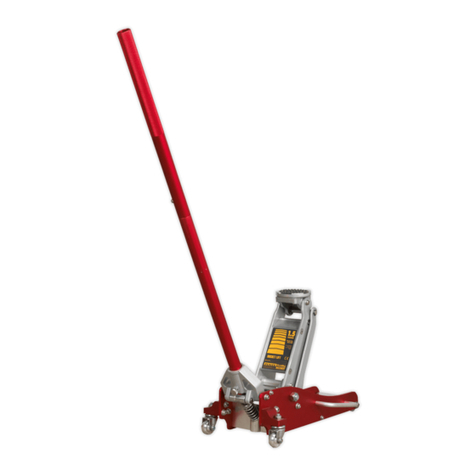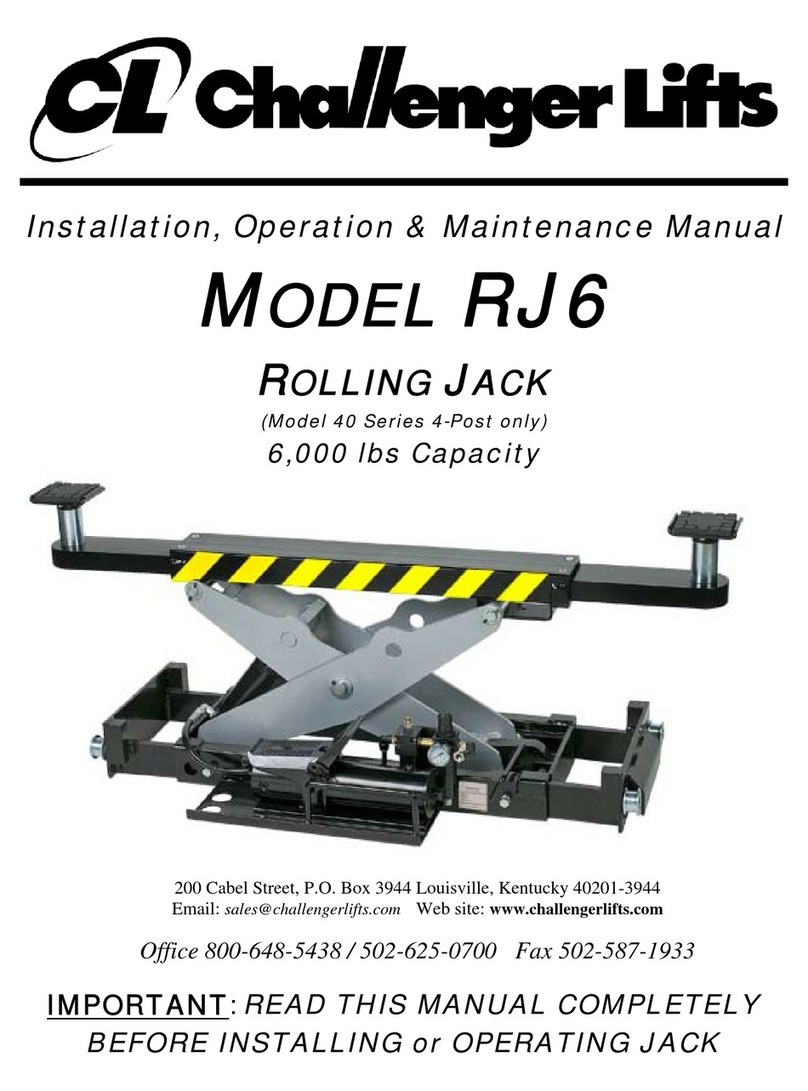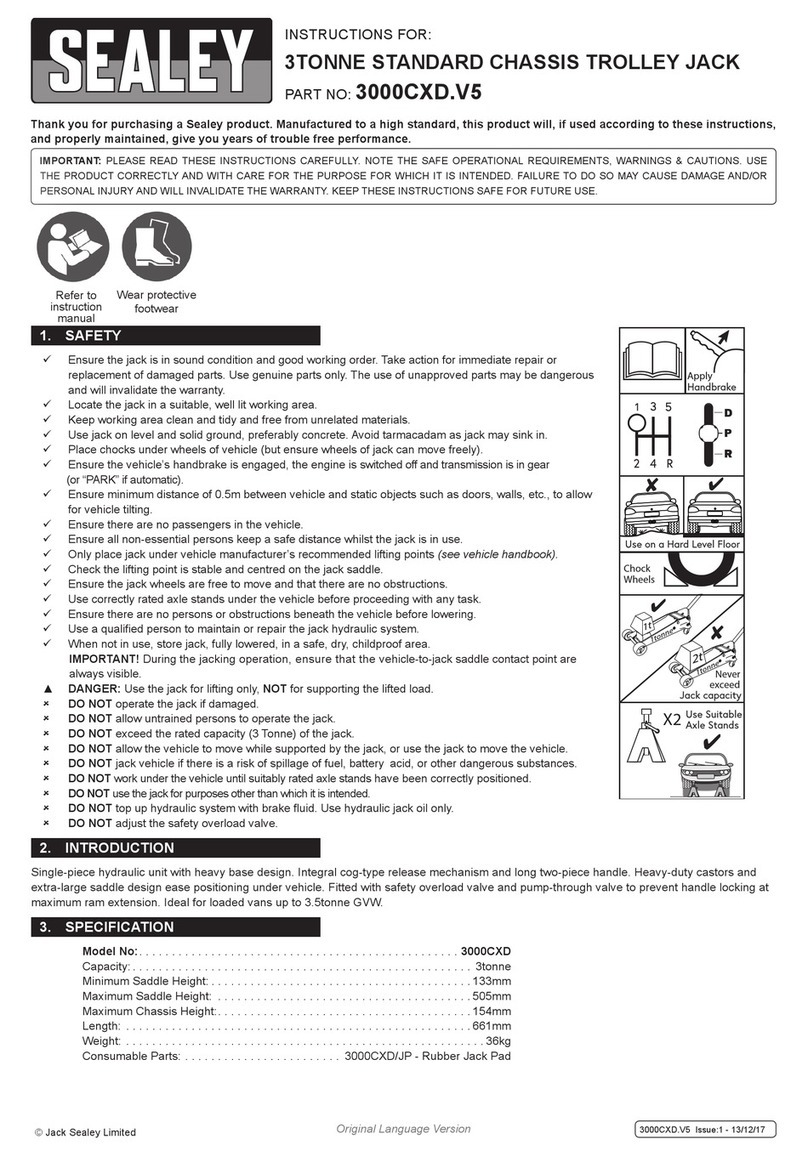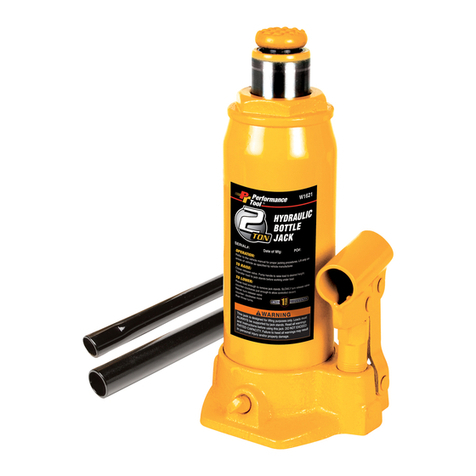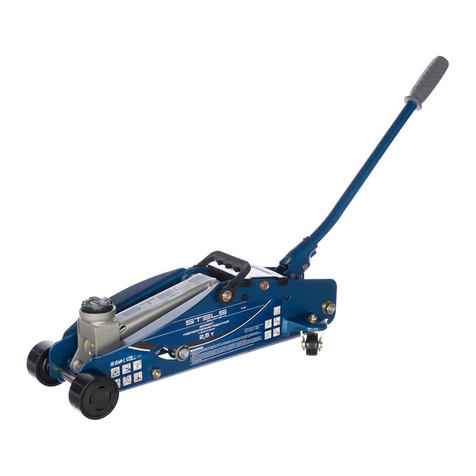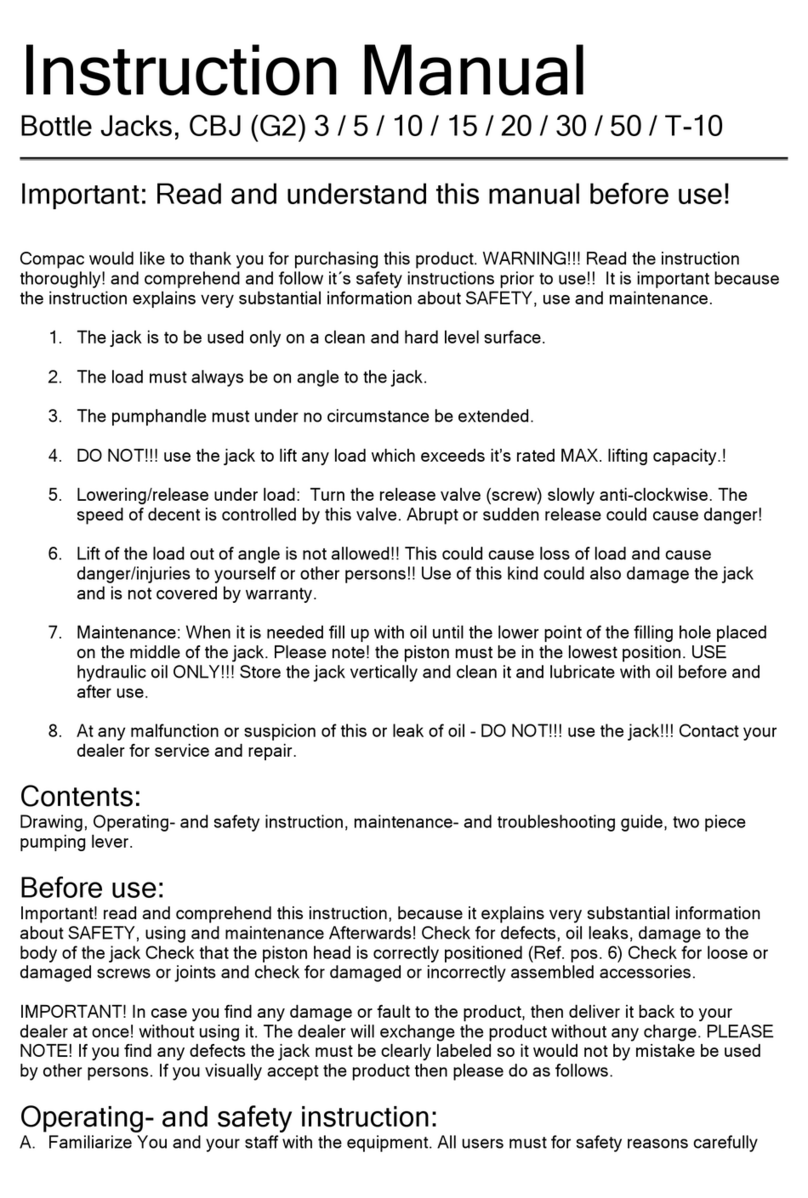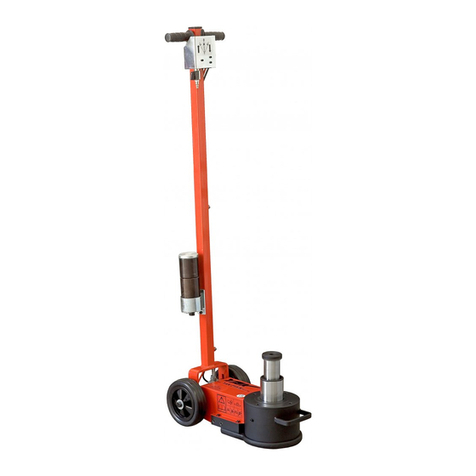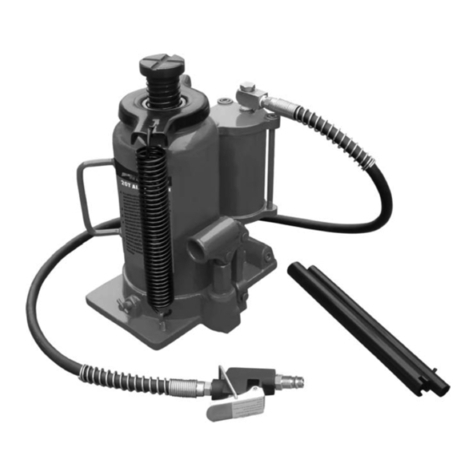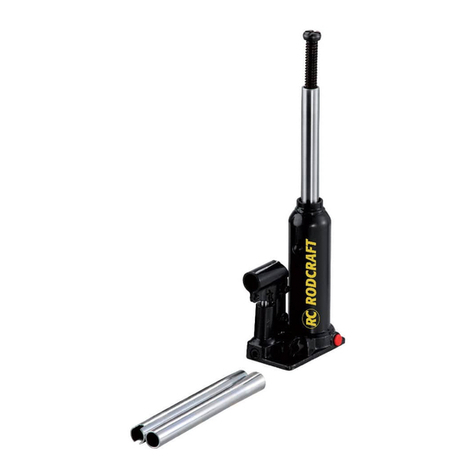Setec S.E.L. 5 User guide

ISOMOVE
®
MARTINETTI A VITE SENZA FINE
WORM SCREW JACKS
VÉRINS A VIS
SPINDELHUBGETRIEBE
MANUALE USO E MANUTENZIONE
USE AND MAINTENANCE GUIDE
NOTICE D’EMPLOI ET D‘ENTRETIEN
BEDIENUNGS- UND WARTUNGSHANDBUCH
S.E.L.
S.E.P.

2
www.setec-group.it
Fig. 1
P/N PZ DESCRIZIONE DESCRIPTION
Pcs
11Vite rotante Rotating screw
2 1 Chiocciola traslante Travelling nut
31Ghiera di chiusura Threaded ring
41O-ring superiore Upper O-ring
52Tenuta ruota Wheel seal
62Cuscinetto ruota Wheel bearing
71Ruota elicoidale Worm wheel
81Distanziale Spacer ring
92Dado Nut
10 4 Grano filettato Threaded pin
11 1 Cassa Housing
12 1 Ingrassatore Grease nipple
13 1 O-ring inferiore Lower O-ring
14 1 Tappo Plug
15 2 Cuscinetto vite senza fine Worm screw bearing
16 2 Seeger Seeger
17 2 Anello di tenuta Seal
18 2 Chiavetta vite senza fine Worm screw key
19 1 Vite senza fine Worm screw
20 1 Chiavetta vite rotante Rotating screw key
S.E.L. VITE ROTANTE
VITE TRAPEZIA / RICIRCOLO
S.E.L. ROTATING
TRAPEZOIDAL/BALLSCREW SCREW JACK
01
02
03
04
05
06
07
06
08
09
10
10
10
11
12
13
14
15
16
17
15 16 17
18 18
19
20
02
05
24
23
22
21
20
19
18
17
16
15
14
13
12
11
09
08
10
25
05
06
07
06
05
04
03
02
01
01
S.E.L.- S.E.P. Manuale uso e manutenzione
Fig. 2
P/N PZ DESCRIZIONE DESCRIPTION
Pcs
11Attacco vite Screw end
21Ghiera di chiusura Threaded ring
31Vite traslante Travelling screw
41O-ring superiore Upper O-ring
52Cuscinetto ruota Wheel bearing
62Tenuta ruota Wheel seal
71Ruota elicoidale Worm wheel
82Seeger Seeger
92Anello di tenuta Seal
10 2 Cuscinetto vite senza fine Worm screw bearing
11 2 Chiavetta vite senza fine Worm screw key
12 1 Vite senza fine Worm screw
13 1 Cassa Housing
14 1 Ingrassatore Grease nipple
15 1 O-ring inferiore Lower O-ring
16 2 Vite TSEI TSEI screw
17 1 Bussola inferiore Lower sleeve
18 1 Cannotto di protezione Protection tube
19 2 Fine corsa Limit switch
20 1 Antirotazione Antirotation device
21 3 Vite TSEI TSEI screw
22 1
Pattino (solo per FC e AR)
Guide (only for FC & AR)
23 1
Tappo cannotto di protezione
Protection tube plug
24 1 Grano filettato Threaded pin
25 4 Grano filettato Threaded pin
S.E.L. VITE TRASLANTE
VITE TRAPEZIA
S.E.L. TRAVELLING
TRAPEZOIDAL SCREW JACK
Attacco / End type A2
Attacco / End type A1
Attacco / End type A3
CHIOCCIOLA / NUT SG
Solo versioni a ricircolo
Only for ballscrew versions
Attacco / End type 1
CHIOCCIOLA / NUT SH-SK
Solo versioni a ricircolo
Only for ballscrew versions
ITALIANO / ENGLISH

3
www.setec-group.it
Fig. 3
21 20
16
19
18
17
15
14
13
12
11
05
10
09
08
07
06
05
04
03
02
01
16
01
02
03
04
05
06
08
07
09
P/N PZ DESCRIZIONE DESCRIPTION
Pcs
11Vite traslante a ricircolo Travelling ballscrew
21Ghiera di chiusura Threaded ring
31O-ring superiore Upper O-ring
41Tenuta Seal
52Cuscinetto ruota Wheel bearing
61Distanziale cuscinetto Bearing spacer
71Chiocciola a ricircolo Ballscrew nut
82Spina di centraggio Setting pin
91Ruota elicoidale Worm wheel
10 6 Vite TCEI TCEI screw
11 1 Anello di tenuta Wheel seal
12 4 Grano filettato Threaded pin
13 1 Cassa Housing
14 1 O-ring inferiore Lower O-ring
15 1 Bussola inferiore Lower sleeve
16 2 Ingrassatore Grease nipple
17 2 Anello di tenuta Seal
18 2 Cuscinetto vite senza fine Worm screw bearing
19 2 Seeger Seeger
20 1 Vite senza fine Worm screw
21 2 Chiavetta vite senza fine Worm screw key
P/N PZ DESCRIZIONE DESCRIPTION
Pcs
11Vite traslante a ricircolo Travelling ballscrew
21Ghiera di chiusura Threaded ring
31O-ring superiore Upper O-ring
41Tenuta Seal
52Cuscinetto ruota Wheel bearing
61Distanziale cuscinetto Bearing spacer
71Chiocciola a ricircolo Ballscrew nut
81Ruota elicoidale Worm wheel
91Ingrassatore Grease nipple
S.E.L. VITE TRASLANTE
VITE A RICIRCOLO DI SFERE
S.E.L. TRAVELLING BALLSCREW JACK
CHIOCCIOLA / NUT SG
S.E.L. VITE TRASLANTE
VITE A RICIRCOLO DI SFERE
S.E.L. TRAVELLING BALLSCREW JACK
CHIOCCIOLA / NUT SH/SK
S.E.L.- S.E.P. Use and maintenance guide
Fig. 4
ITALIANO / ENGLISH

4
www.setec-group.it
Fig. 5
Fig. 6
09
08
07
06
05
01
04
03
02
08
07
06
05
04
03
02
01
P/N PZ DESCRIZIONE DESCRIPTION
Pcs
11Anello di centraggio Centering ring
24Vite TCEI TCEI screw
31Flangia Flange
44Vite TCEI TCEI screw
52Grano filettato Threaded pin
6 1 Giunto Coupling
71Campana motore Motor bell
84Vite TCEI TCEI screw
91Motore Motor
P/N PZ DESCRIZIONE DESCRIPTION
Pcs
11Vite senza fine Worm screw
21Cuscinetto Worm screw bearing
31Seeger Seeger
41Anello di tenuta (*) Seal
51Campana motore Motor bell
64Vite TCEI TCEI screw
71Motore Motor
84Vite TCEI TCEI screw
S.E.L.
MOTOMARTINETTI / MOTORIZED SCREW JACKS MG
S.E.L.
MOTOMARTINETTI / MOTORIZED SCREW JACKS MD
S.E.L.- S.E.P. Manuale uso e manutenzione
(*)Non presente in caso di cuscinetto schermato.
Not present when shielded bearing is used.
ITALIANO / ENGLISH

5
www.setec-group.it
Fig. 7
Fig. 8
P/N PZ DESCRIZIONE DESCRIPTION
Pcs
11Vite traslante Travelling screw
21Ghiera di chiusura Threaded ring
31O-ring superiore Upper O-ring
41Seeger Seeger
51Chiocciola di sicurezza Safety nut
63Spina di centraggio Setting pin
72Cuscinetto ruota Wheel bearing
81Ruota elicoidale Worm wheel
91Anello di tenuta Wheel seal
10 4 Grano filettato Threaded pin
11 1 Cassa Housing
12 2 Ingrassatore Grease nipple
13 1 O-ring inferiore Lower O-ring
14 1 Bussola inferiore Lower sleeve
15 2 Anello di tenuta Seal
16 2 Cuscinetto vite senza fine Worm screw bearing
17 2 Seeger Seeger
18 1 Vite senza fine Worm screw
19 2 Chiavetta vite senza fine Worm screw key
S.E.L.
VERSIONE CON CHIOCCIOLA DI SICUREZZA
SAFETY NUT VERSION SS
S.E.L.
VERSIONE CON CHIOCCIOLA RECUPERO GIOCHI
ANTI BACKLASH NUT VERSION SB
P/N PZ DESCRIZIONE DESCRIPTION
Pcs
11Vite traslante Travelling screw
24Grano filettato Threaded pin
31Ghiera di chiusura Threaded ring
41O-ring superiore Upper O-ring
51Flangia Flange
61Cuscinetto ruota Wheel bearing
73Spina di centraggio Setting pin
81
Chiocciola recupero giochi
Antibacklash nut
91Ruota elicoidale Worm wheel
10 1 Cuscinetto ruota Wheel bearing
11 1 Anello di tenuta Wheel seal
12 4 Grano filettato Threaded pin
13 1 Cassa Housing
14 1 O-ring inferiore Lower O-ring
15 1 Bussola inferiore Lower sleeve
16 2 Ingrassatore Grease nipple
17 2 Anello di tenuta Seal
18 2 Seeger Seeger
19 2 Cuscinetto vite senza fine Worm screw bearing
20 1 Vite senza fine Worm screw
21 2 Chiavetta vite senza fine Worm screw key
19
18
17
16
15
14
13
12
10 09
07
08
07 06
05 04
03
02
01
11
21
20
19
18
17
16
15
14
13
12 11
10
09
08
07 06
05
04
03
02
01
S.E.L.- S.E.P. Use and maintenance guide
Foro per ispezione e verifica usura
Inspection and wear check hole
ITALIANO / ENGLISH

6
www.setec-group.it
Fig. 9 Fig. 10
Fig. 11
23
22
21
20
19
S.E.P. VITE ROTANTE / TRASLANTE
VITE TRAPEZIA / RICIRCOLO
S.E.P. ROTATING / TRAVELLING
TRAPEZOIDAL/BALLSCREW JACK
Solo / Only S.E.P. 500, 1000, 1500
P/N PZ DESCRIZIONE DESCRIPTION
Pcs
11Tappo Plug
22Grano filettato Threaded pin
31Flangia Flange
42Cuscinetto ruota Wheel bearing
51Ruota elicoidale Worm wheel
62Ghiera filettata Nut
71Rondella Washer
81Distanziale Spacer
91Vite rotante Rotating screw
10 1 Cassa Housing
11 1 Chiavetta vite rotante Rotating screw key
12 1 Ingrassatore Grease nipple
13 2 Anello di tenuta Seal
14 2 Seeger Seeger
15 2 Cuscinetto vite senza fine Worm screw bearing
16 1 Vite senza fine Worm screw
17 2 Chiavetta vite senza fine Worm screw key
18 1 Ghiera di chiusura Threaded ring
19 1 Chiocciola traslante Travelling nut
20 2 Grano filettato Threaded pin
S.E.P. VITE ROTANTE
VITE TRAPEZIA / RICIRCOLO (Quadra dove disponibile)
S.E.P. ROTATING
TRAPEZOIDAL/BALLSCREW JACK (Squared where available)
Soluzione / Solution B
19
18
17
16
15
15 14
13
12
11
10
09
08
07
07
06
05
04
03
02
01
S.E.L.- S.E.P. Manuale uso e manutenzione
P/N PZ DESCRIZIONE DESCRIPTION
Pcs
11Chiocciola traslante Travelling nut
21Vite rotante Rotating screw
34Grano filettato Threaded pin
41Ghiera di chiusura Threaded ring
51Flangia Flange
61Chiavetta vite rotante Rotating screw key
72Cuscinetto ruota Wheel bearing
81Ruota elicoidale Worm wheel
91Cassa Housing
10 1Ingrassatore Grease nipple
11 2Anello di tenuta Seal
12 2Seeger Seeger
13 2Cuscinetto vite senza fine Worm screw bearing
14 1Vite senza fine Worm screw
15 2Chiavetta vite senza fine Worm screw key
16 1Distanziale Spacer
17 2Ghiera filettata Nut
18 1Rondella Washer
19 1Tappo Plug
S.E.P. VITE ROTANTE
VITE TRAPEZIA / RICIRCOLO
(Quadra dove disponibile)
S.E.P. ROTATING
TRAPEZOIDAL/BALLSCREW JACK
(Squared where available)
Soluzione / Solution A
P/N PZ DESCRIZIONE DESCRIPTION
Pcs
19 1 Cuscinetto vite senza fine Worm screw bearing
20 1 Piattello Plate
21 1 Tenuta Seal
22 8 Rondella Washer
23 8 Vite TE TE screw
19
20
18
17
16
15
14
13
12
11
10
09
08
07
06
05
04
04
03
02
01
ITALIANO / ENGLISH

7
www.setec-group.it
Fig. 12
Fig. 13
P/N PZ DESCRIZIONE DESCRIPTION
Pcs
11Vite traslante Travelling screw
21Ghiera di chiusura Threaded ring
34Grano filettato Threaded pin
41Flangia Flange
52Cuscinetto ruota Wheel bearing
61Ruota elicoidale Worm wheel
71Cassa Housing
81Ingrassatore Grease nipple
92Anello di tenuta Seal
10 2 Seeger Seeger
11 2 Cuscinetto vite senza fine Worm screw bearing
12 1 Vite senza fine Worm screw
13 2 Chiavetta vite senza fine Worm screw key
14 1 Piattello finecorsa Stroke-end ring
15 1 Cannotto protezione Protection tube
16 2 Fine corsa Limit switch
A1
A2
A4
A3
16
15
14
13
12
11 10
09
08
07
06
05
04
03
02
01
21
20
22
23
24
25
24
23
21
22
20
26
16
15
14
13
12
12
11
10
09 08
07
06
05
04
03
03
02
01
S.E.P.
VITE TRASLANTE VITE TRAPEZIA (Quadra dove disponibile)
TRAVELLING TRAPEZOIDAL SCREW JACK (Squared where available)
P/N PZ DESCRIZIONE DESCRIPTION
Pcs
20 1 Chiavetta antirotazione Antirotation key
21 2 Grano filettato Threaded ring
22 1 Flangia Flange
23 1 Vite TCEI Screw TCEI
24 1 Vite traslante Travelling screw
P/N PZ DESCRIZIONE DESCRIPTION
Pcs
11Vite traslante Travelling screw
21Ghiera di chiusura Threaded ring
34Grano filettato Threaded pin
41Piattello finecorsa Stroke-end ring
51Cassa Housing
62Anello di tenuta Seal
72Seeger Seeger
82Cuscinetto vite senza fine Worm screw bearing
91Vite senza fine Worm screw
10 2 Chiavetta vite senza fine Worm screw key
11 1 Ingrassatore Grease nipple
12 2 Cuscinetto ruota Wheel bearing
13 1 Ruota elicoidale Worm wheel
14 1 Flangia Flange
15 1 Cannotto protezione Protection tube
16 2 Finecorsa Limit switch
S.E.P.
VITE TRASLANTE VITE TRAPEZIA (Quadra dove disponibile)
TRAVELLING TRAPEZOIDAL SCREW JACK (Squared where available)
SOLUZIONE / SOLUTION A
SOLUZIONE / SOLUTION B
SOLUZIONE / SOLUTION A
Versione con antirotazione
Back stop version
SOLUZIONE / SOLUTION B
Versione con antirotazione
Back stop version
P/N PZ DESCRIZIONE DESCRIPTION
Pcs
20 1 Chiavetta antirotazione Antirotation key
21 2 Grano filettato Threaded ring
22 1 Flangia Flange
23 1 Vite TCEI Screw TCEI
24 1 Ghiera di chiusura Threaded ring
25 2 Grano filettato Threaded ring
26 1 Vite traslante Travelling screw
S.E.L.- S.E.P. Use and maintenance guide
ITALIANO / ENGLISH

8
www.setec-group.it
P/N PZ DESCRIZIONE DESCRIPTION
Pcs
11Vite traslante a ricircolo Travelling ballscrew
21Ghiera di chiusura Threaded ring
34Grano filettato Threaded pin
41Flangia Flange
51Controflangia Counter-flange
62Cuscinetto ruota Wheel bearing
71Distanziale cuscinetto Bearing spacer
86Grano filettato Threaded pin
91Chiocciola a ricircolo Ballscrew nut
10 1 Controflangia chiocciola Nut counter-flange
11 2 Spina di centraggio Setting pin
12 1 Ruota elicoidale Worm wheel
13 1 Ingrassatore Grease nipple
06
12
13
14
16
15
11
10
09
08
07
02
05
04
03
02
01
12
11
10
09
08
07
06
03
05
04
02
01
13
07
06
05
04
03
02
01
Fig. 15
Versione con chiocciola / Nut version
SG
Versione con chiocciola / Nut version
SH / SK
SOLUZIONE / SOLUTION B
P/N PZ DESCRIZIONE DESCRIPTION
Pcs
11Motore Motor
21Giunto Coupling
32Grano filettato Threaded pin
48Vite TCEI TCEI screw
51Campana motore Motor bell
64Vite TCEI TCEI screw
71Anello di tenuta Seal
S.E.P.
MOTOMARTINETTI / MOTORIZED SCREW JACKS
Versione / Version MG
Fig. 14
P/N PZ DESCRIZIONE DESCRIPTION
Pcs
11Cassa Housing
22Cuscinetto ruota Wheel bearing
31Ruota elicoidale Worm wheel
4 1 Distanziale cuscinetto Bearing spacer
51Chiocciola a ricircolo Ballscrew nut
61Distanziale cuscinetto Bearing spacer
71Flangia Flange
81Vite traslante a ricircolo Travelling ballscrew
91Ghiera di chiusura Threaded ring
10 2 Grano filettato Threaded pin
11 2 Ingrassatore Grease nipple
12 2 Anello di tenuta Seal
13 2 Seeger Seeger
14 2 Cuscinetto vite senza fine Worm screw bearing
15 1 Vite senza fine Worm screw
16 2 Chiavetta vite senza fine Worm screw key
S.E.P.
VITE TRASLANTE VITE A RICIRCOLO DI SFERE
TRAVELLING BALLSCREW JACK
S.E.L.- S.E.P. Manuale uso e manutenzione
ITALIANO / ENGLISH

9
www.setec-group.it
Fig. 16
Fig. 17
18 17
16
19
20
15
14
13
12
11
10
09
08 07
06
05
04
03
02
01
11
10
09
08
07
06
05
04
03
02
01
14
16
12
13
15
17
S.E.P.
VERSIONE CON CHIOCCIOLA DI SICUREZZA
SEP SAFETY NUT VERSION
P/N PZ DESCRIZIONE DESCRIPTION
Pcs
11Vite traslante Travelling screw
21Ghiera di chiusura Threaded ring
32Grano filettato Threaded pin
41Flangia Flange
51Tappo filettato Threaded plug
61Cuscinetto ruota Wheel bearing
71Distanziale cuscinetto Bearing spacer
82Grano filettato Threaded pin
91Chiocciola di sicurezza Safety nut
10 2 Spine di centraggio Setting pin
11 1 Distanziale Spacer
12 1 Ruota elicoidale Worm wheel
13 1 Cuscinetto ruota Wheel bearing
14 1 Cassa Housing
15 2 Ingrassatore Grease nipple
16 2 Anello di tenuta Seal
17 2 Seeger Seeger
18 2 Cuscinetto vite senza fine Worm screw bearing
19 2 Chiavetta vite senza fine Worm screw key
20 1 Vite senza fine Worm screw
P/N PZ DESCRIZIONE DESCRIPTION
Pcs
11Vite traslante Travelling screw
24Grano filettato Threaded pin
31Ghiera di chiusura Threaded ring
41Flangia Flange
51Controflangia Counter-flange
61Cuscinetto ruota Wheel bearing
72Spine di centraggio Setting pin
81
Chiocciola recupero gioco
Antibacklash nut
91Ruota elicoidale Worm wheel
10 1 Cuscinetto ruota Wheel bearing
11 1 Cassa Housing
12 2 Anello di tenuta Seal
13 2 Seeger Seeger
14 2 Ingrassatore Grease nipple
15 2 Cuscinetto vite senza fine Worm screw bearing
16 2 Chiavetta vite senza fine Worm screw key
17 1 Vite senza fine Worm screw
S.E.P.
VERSIONE CON CHIOCCIOLA RECUPERO GIOCHI
ANTI BACKLASH NUT VERSION
S.E.L.- S.E.P. Use and maintenance guide
ITALIANO / ENGLISH

10
www.setec-group.it
xxxxxxxxx
xxxx
SCREW JACK S.E.L.
Job N°
Stroke
1 / xx
xx
xxxx
Ratio
Lead
Setec S.p.A. - setec.to@setec- roup.it
Phone +39 011 4518611 - fax +39 011 4704891
xxxxxxxxx
xxxx
SCREW JACK S.E.P.
Job N°
Stroke
1 / xx
xx
xxxx
Ratio
Lead
Ph +39 011 4518611
setec.to@setec- roup.it
Corsa / Stroke mm]
Passo / Lead mm]
Commessa n° / Order n°
Grandezza /Size
Rapporto di riduzione
nominale
Nominal ratio
[a [b
Fig. 18 Targhetta identificativa martinetti S.E.L. a] e martinetti S.E.P. b] / Designation plate S.E.L. a] and S.E.P. b]
In caso di assistenza siete pregati di annotare ciascun dato in modo da identificare il prodotto in oggetto.
If you need assistance, you are pleased to send us every data to let us identify the product.
IDENTIFICAZIONE
Su ogni prodotto è applicata una targhetta identificativa che riporta i
principali dati che lo caratterizzano:
3.1.0 TIPOLOGIA DI IMPIEGO
3.1.1 Temperatura di lavoro: -20° C; +70° C
3.1.2 Grado di protezione IP: tutti i martinetti standard sono realizzati
con grado di protezione IP dipendente dal modello e a condizione
che il motore elettrico raggiunga il grado di protezione del
martinetto stesso; contattare il nostro servizio tecnico per
ulteriori informazioni.
3.1.3 Intermittenza di lavoro: tutti i martinetti standard garantiscono
le prestazioni nominali indicate nel nostro catalogo in assenza
di urti e di vibrazioni, con carichi esclusivamente di tipo assiale
ed una temperatura ambiente di 20°C. Sulla base del fattore di
servizio desiderato e del tipo di martinetto scelto (taglia,
diametro e tipo di vitone di sollevamento) occorre necessariamente
verificare il corrispondente valore di CAPACITÀ TERMICA Ct
(vedi catalogo “SETEC S.E.L. - S.E.P”).
Non oltrepassare mai, durante il funzionamento, i limiti imposti
dalla capacità termica del martinetto scelto, in base alle condizioni
di carico e velocità di sollevamento, per non pregiudicare
irrimediabilmente il martinetto.
Per intermittenze di lavoro gravose, contattate il nostro servizio
tecnico.
3.1.4 Normative: Tutti i prodotti SETEC sono costruiti in accordo alla
normativa CEE sulle macchine; come componenti di macchine i
nostri attuatori possono essere installati solo su macchinari con
caratteristiche rispondenti alla normativa comunitaria sulle
macchine secondo le seguenti:
EN 292-1, EN 2.1991, EN 954-1, EN 294.1992, EN 349.1993,
EN 418.1992.
In caso di installazione dei nostri prodotti su macchinari che non
seguono le normative di legge, la SETEC declina ogni respon-
sabilità su possibili danni arrecati agli attuatori o per
l’incolumità degli operatori.
SCREW JACK DESIGNATION
In every product there is a plate with all the main info about the
product you have purchased:
3.1.0
OPERATING ENVIRONMENT
3.1.1
Operating temperature: - 20° C; +70° C
3.1.2
IP rating: all standard screw jacks are made in IP54 rating;
contact our technical service for more informations.
3.1.3
Duty cycle: all standard screw jacks guarantee the nominal
performance indicated in our catalogue, in absence of
impacts and vibrations, with purely axial forces and an
ambient temperature of 20° C. On the base of the desired
service factor and screw jack version (size, diameter and
screw type), check the thermal capacity Ct (see Setec S.E.L. -
S.E.P. catalogue).
Never exceed the limits imposed by the thermal capacity,
according to load and lifting speed, not to damage the
screw jack.
Contact our technical service for heavier working conditions.
3.1.4
European community rules: All SETEC products are realized
according to CEE rules about the machines; as machine
elements, our screw jacks can be used only inside machines
in accordance with the followings CEE rules:
EN 292-1, EN 2.1991, EN 954-1, EN 294.1992, EN 349.1993,
EN 418.1992.
If our screw jacks are used inside equipments not according
to the rules above, SETEC doesn’t guarantee for possible
damages or the safety of the operators.
S.E.L.- S.E.P. Manuale uso e manutenzione
ITALIANO / ENGLISH

11
www.setec-group.it
3.2.0
INSTALLATION
NOTE: before starting the machinery, users must read the follo-
wing maual; keep this and all the related documents in an a place
accessible to the maintenance staff.
SETEC could assert the right not to repair or to replace under war-
ranty when damages are due to uncorrect use of the screw jacks
or wrong maintenance.
For any other information, read the specific catalogue SETEC
“S.E.L. - S.E.P.” that is an integral part of this manual.
3.3.0
STARTING CHECKS
3.3.1
All SETEC products are carefully tested before delivery; for
precautionary measure, it’s important to verify that the object
rotates freely and the correct locking of screws of the plates
(only S.E.P. 500, 1000 and 1500) (Fig. 9-20).
3.3.2
Ensure that the structure the screw jack is mounted on is suf-
ficiently strong to stand the maximum load without having
any deformation which could affect the good operation of the
screw jack.
3.3.3
When one or more screw jacks are installed together, pay
particular attention that the threads are parallel to each other
and that the transmission shafts are perfectly aligned.
3.3.4
All rotating and moving parts must be guarded to prevent
accidents.
3.3.5
Verify that buckling load isn’t overcome in order to avoid
damages.
3.3.6
NOTE: screw jacks are component able to stand ONLY
purely axial forces (along the screw axis).
No out of axial or radial forces can be supported.
3.3.7
Clean the screw jack and the threaded rod to avoid that
impurity may enter, using the right products not to corrode
the surface of the materials. Dust and abrasives may accele-
rate the wear of inner components.
3.3.8
Lubricate the threaded screw before jack start up and maintain
lubrication during operation to reduce wear and temperature
raise.
3.3.9
Our screw jacks are supplied with nipples (Fig. 1-12) on the
housing, for lubrication. Verify the correct locking of the
screw to avoid the grease to go out.
3.3.10
To safeguard the life time of the screw jack it’s very important
to keep off any impact and vibration; it’s well-known that
ballscrews and bearings are strongly stressed by impacts par-
ticularly when the screw jack is motionless.
3.3.11
Never exceed the limits of the nominal load stated in order
to avoid serious damage to the system, strongly reduced
life time and permanent deformations that could compromi-
se the proper operation of the screw jack.
3.2.0
INSTALLAZIONE
N.B. Prima di rendere operativa la macchina occorre leggere
attentamente il seguente manuale e seguirne le indicazioni riportate.
Tenere la seguente pubblicazione e tutti i documenti a cui si fa rife-
rimento in luogo accessibile a ciascun operatore ed al per-
sonale di manutenzione.
La SETEC si riserva il diritto di non provvedere alla riparazione o alla
sostituzione in garanzia dei suoi prodotti in caso di danni dovuti
ad un non corretto utilizzo del martinetto e/o ad una errata manu-
tenzione.
Per qualunque altra informazione Vi rimandiamo alla consultazione dello
specifico catalogo SETEC S.E.L.- S.E.P. che rappresenta parte inte-
grante dello stesso.
3.3.0
CONTROLLI PRECAUZIONALI ALL’AVVIO
3.3.1 Tutti i nostri prodotti sono accuratamente controllati prima
della spedizione, tuttavia si richiede a scopo precauzionale di
verificare possibili impedimenti al movimento degli organi
interni ed il serraggio delle viti dei coperchi laterali (solo S.E.P.
500, 1000 e 1500) (Fig. 9-20).
3.3.2 Accertarsi che la struttura su cui è montato il martinetto sia in
grado di sopportare il carico massimo previsto senza subire
delle deformazioni che comprometterebbero il funzionamento
del martinetto stesso.
3.3.3 Nel caso di accoppiamento di più martinetti, curare particolarmente
il parallelismo delle aste filettate e l’allineamento fra gli alberi
di trasmissione.
3.3.4 Per prevenire incidenti, tutte le parti rotanti e mobili devono
essere provviste di protezione.
3.3.5 Verificare che il carico critico in compressione relativo alla corsa
non venga mai superato per evitare gravi danni al martinetto.
3.3.6 N.B. I martinetti sono progettati per movimentare carichi
nella sola componente assiale; un carico radiale, seppur di
piccola entità, o un carico disassato potrebbero compromette-
re l’affidabilità e la durata utile del prodotto.
3.3.7 Provvedere alla pulizia del martinetto e nello specifico dell’asta
filettata; evitare che impurità e smeriglio si accumulino
sull’asta filettate per evitare che possano penetrare all’interno
del sistema. Polvere e abrasivi potrebbero accelerare l’usura
degli organi in movimento.
3.3.8 Lubrificare l’asta filettata prima della messa in funzione del
martinetto e mantenerla lubrificata durante il funzionamento
per ridurre l’usura e mantenere il livello di temperatura
contenuto.
3.3.9 I nostri martinetti sono forniti di ingrassatori (Fig. 1-12) sulla
cassa da utilizzare per la lubrificazione. Verificare il corretto
serraggio dell’ingrassatore per impedire la fuoriuscita di gras-
so lubrificante o l’ingresso di impurità nel sistema.
3.3.10 È indispensabile, al fine di salvaguardare la durata del martinet-
to, evitare qualsiasi urto e/o forti vibrazioni al sistema con mag-
giore cautela laddove è stata scelta una vite a ricircolo di
sfere; è infatti risaputo che i cuscinetti e le sfere subiscono
forti stress meccanici in caso di urto.
3.3.11 Evitare di superare i limiti di carico nominale dichiarato per non
arrecare gravi danni al sistema con conseguenti durate forte-
mente ridotte e deformazioni permanenti che pregiudichereb-
bero la funzionalità del martinetto.
Superare i limiti di coppia nominale in ingresso al martinetto potreb-
be determinare gravi danni al sistema e pregiudicarne la vita utile.
S.E.L.- S.E.P. Use and maintenance guide
ITALIANO / ENGLISH

12
www.setec-group.it
3.3.12
Never use the screw jack inner parts as mechanical shoul-
der!
3.3.13
When the screw jack is used in application in which the load
is moved along the vertical axis it’s necessary to provide the
screw jack with a brake that stops the load when the motor is
off; it’s due to the reversibility of the ballscrew.
3.3.14
In S.E.P. and S.E.L. screw jacks the antirotation option device
is available; this device is not a structural part, so it isn’t able
to stand external torque.
In S.E.P. screw jacks the antirotation is realized with a screw
milling, it reduces the screw jack buckling load, contact our
technical service for more informations.
3.3.15
If the customer should realize his own motor bell house, use
the centring in the housing near the worm screw, after the
removal of the V-seal (Fig. 1-17).
3.4.0
MOTOR CONNECTION IN “MD” VERSION
(ONLY FOR S.E.L. SCREW JACKS) (Fig. 06)
In “MD” version the motor shaft is fitted directly into the hollow shaft
of the screw jack without any coupling.
3.4.1
Align motor shaft (07) to the hollow screw jack shaft (01);
3.4.2
centre the key of the motor shaft with the keyway of the hol-
low shaft (01);
3.4.3
centre motor flange (07) in the bell house (05);
3.4.4
align bell (05) and motor flange (07) mounting holes;
3.4.5
lock the screws (08).
3.5.0
MOTOR CONNECTION IN “MG” VERSION
(S.E.L. SCREW JACKS) (Fig. 05)
3.5.1
Fix the flange (03) on the motor bell house (07) using screws (02);
3.5.2
put the coupling (06) on the worm screw paying attention that
the threaded pin (05) is aligned with the hole in motor bell (07);
3.5.3
place the V-seal (01) and fix flange (03) on screw jack housing
using screws (04);
3.5.4
rotate worm screw paying attention that the threaded pin (05)
is aligned with the hole in motor bell house and lock the
coupling (06);
3.5.5
clamp motor shaft (09) in coupling (06) centring the flange on
motor bell (07) and lock screws (08).
3.6.0
MOTOR CONNECTION IN “MG” VERSION
(S.E.P. SCREW JACKS) (Fig. 15)
3.6.1
Place V-seal (07) on the worm screw and fix motor bell house
(05) on the screw jack housing by its screws (04);
3.6.2
lock coupling (02) on the worm screw paying attention that the
threaded pin (03) is aligned with the hole in motor bell
house (05);
3.6.3
clamp motor shaft (01) in coupling centring the flange on motor
bell house (05), lock the screws (06) and the threaded pin (03).
3.7.0
ORDINARY MAINTENANCE AND SCHEDULED
CONTROLS
3.7.1
A regular maintenance together with a proper use avoid
problems in terms of reliability and safety, furthermore it
guarantees functionality and quality during the product life; so
we ask you to have a scrupulous care of scheduled maintenan-
3.3.12 Non portare mai il martinetto a battuta meccanica!
3.3.13
In caso di applicazioni con vite di sollevamento a ricircolo di sfere,
in cui la traslazione avviene lungo l’asse verticale, occorre preve-
dere un sistema frenante che mantenga fermo il carico, in quanto
il sistema è reversibile, quando il motore è non alimentato.
3.3.14 Nei martinetti di tipo S.E.P. e S.E.L. è prevista l’opzione “anti
rotazione”; questo dispositivo non è strutturale, non è in
grado, quindi, di sopportare momenti torcenti esterni.
Nei martinetti S.E.P. la fresatura sull’asta filettata, dovuta
all’antirotazione, riduce la resistenza a carico di punta del sistema,
contattare il nostro servizio tecnico per eventuali chiarimenti.
3.3.15 Nel caso in cui il cliente desideri realizzare una campana attac-
co motore per conto proprio, è possibile utilizzare il centrag-
gio sulla cassa del martinetto in prossimità della vite senza
fine, previo smontaggio dell’anello di tenuta (Fig. 1-17).
3.4.0
MONTAGGIO DEL MOTORE NELLA VERSIONE
“MD” (SOLO MARTINETTI S.E.L.) (Fig. 06)
Nelle versioni “MD” il motore è montato direttamente sulla campana
di collegamento al martinetto sfruttando l’albero cavo della vite
senza fine, senza interposizione, cioè, del giunto di trasmissione.
3.4.1 Allineare l’albero del motore (07) alla vite senza fine cava (01);
3.4.2 centrare la chiavetta dell’albero motore sulla cava della vite
senza fine (01);
3.4.3 centrare la flangia del motore (07) sulla campana (05);
3.4.4 allineare i fori di fissaggio di campana (05) e flangia motore (07);
3.4.5 avvitare le viti di fissaggio (08).
3.5.0
MONTAGGIO DEL MOTORE NELLA VERSIONE
“MG” (MARTINETTI S.E.L.) (Fig. 05)
3.5.1 Fissare il distanziale (03) sulla campana (07) mediante le viti (02);
3.5.2 calzare il giunto (06) sulla vite senza fine ad una quota tale che
il grano di bloccaggio (05) sia visibile attraverso il foro sulla
campana (07);
3.5.3 fissare il distanziale (03) sulla cassa del martinetto mediante
le viti (04) interponendo l’anello (01);
3.5.4 ruotare la vite senza fine finché il grano (05) non si allinei al
foro sulla campana e bloccare il giunto;
3.5.5 inserire l’albero del motore (09) sul giunto (06) centrando la
flangia sulla campana (07) e serrare le viti (08).
3.6.0
MONTAGGIO DEL MOTORE NELLA VERSIONE
“MG” (MARTINETTI S.E.P.) (Fig. 15)
3.6.1 Calzare l’anello di tenuta (07) sulla vite senza fine del martinet-
to e montare la campana (05) sulla cassa del martinetto
mediante le viti (04);
3.6.2 fissare il giunto (02) sulla vite senza fine finché il grano (03)
non si allinei al foro della campana (05) e serrare il grano;
3.6.3 inserire l’albero motore (01) sul giunto dopo aver centrato la
sua flangia sulla campana (05), bloccare le viti (06) e serrare
il grano (03).
3.7.0
MANUTENZIONE ORDINARIA E CONTROLLI
PERIODICI
3.7.1 Una buona manutenzione del sistema, insieme ad un corretto
utilizzo, evitano problemi legati all’affidabilità e alla sicurezza
garantendone funzionalità e qualità nel tempo, per cui vi chiedia-
mo di seguire scrupolosamente gli interventi di manutenzio-
S.E.L.- S.E.P. Manuale uso e manutenzione
ITALIANO / ENGLISH

13
www.setec-group.it
ne programmata riassunti nella tabella di seguito (Tab. “A”):
Tab. “A”
3.7.2 CONTROLLO SERRAGGIO
3.7.2.1
VITI DI FISSAGGIO COPERCHI (solo S.E.P. 500, 1000 e 1500):
verificare il serraggio delle viti; in caso di condizioni gravose e
con forti vibrazioni intensificarne il controllo (per le coppie di
serraggio vedere Tab. “B”).
3.7.2.2
I martinetti vengono forniti con sistema di bloccaggio dei filet-
ti delle viti di serraggio (Loctite morbida); nel caso di acquisto
di martinetti in versione custom, per consentire il montaggio
del motore, alcune viti non vengono bloccate.
Si consiglia, una volta effettuato il montaggio, di applicare
della Loctite morbida.
Più in generale di seguito vengono allegate le tabelle relative
alle norme sul serraggio; la seguente norma stabilisce i valori
della coppia nominale e relative tolleranze da applicare per il
serraggio della bulloneria in funzione delle applicazioni.
Per la scelta delle classi di serraggio, consultare la Tab. B1 e
definire il bullone da utilizzare, riportato in Tab. B2, consideran-
do le forze di trazione di ogni singolo bullone (Tab. B3).
ce as below summarized (Tab. “A”):
Tab. “A”
3.7.2 SCREW TIGHTENING CHECK
3.7.2.1
PLATE SCREWS (only S.E.P. 500, 1000 and 1500): verify
screw tightening using the specific tool; in heavy load applica-
tions, or in presence of vibrations, intensify the control (see
Tab. “B”).
3.7.2.2
In our screw jacks all the screws are blocked using the “LOCTI-
TE” thread locking system; when a custom screw jack is
bought, to allow motor installation some screws aren’t locked.
Once the motor mounted, we suggest you to apply the LOCTI-
TE system.
In the tabs below you can find the values of tightening torque
of the screws according to European Community rules; the
following rule sets torque and tolerance values to apply for
tightening screws according to the application.
To choose the tightening class, see Tab. B1 and define the
screw to use, seeing Tab. B2, according to the strength of
every screw (Tab. B3).
dopo 2 MESI dall'installazione
2 months after installation
INTERVALLO / FREQUENCY
Entro 6 mesi
Within 6 months
Ogni 500 ore (vite rotante)
every 500 ore (rotating screw jack)
Ogni 200 ore (vite traslante)
every 200 ore (travelling screw jack)
Ogni 12 / 18 mesi
Every 12 / 18 months
Ogni 12 / 18 mesi
Every 12 / 18 months
Ogni 12 / 18 mesi
Every 12 / 18 months
Ogni mese
Once a month
Ogni mese
Once a month
Ogni anno
Once a year
Ogni anno
Once a year
PARTICOLARE / PART INTERVENTO / CHECK
VITI COPERCHI (solo S.E.P. 500 - 1000 - 1500)
PLATE SCREWS (only S.E.P. 500 - 1000 - 1500)
VITE A RICIRCOLO / BALLSCREW
nelle versioni che adottano questo tipo di vite
where available
GIUNTO (solo versioni MG)
COUPLING (only MG versions)
CAMPANA (versioni MD e MG)
MOTOR BELL (only MD and MG versions)
GHIERA REGISTRO CUSCINETTI
BEARINGS THREADED FLANGE
MARTINETTO
SCREW JACK
ASTA FILETTATA
THREADED ROD
CONTROLLO SERRAGGIO
TIGHTEN SCREWS
LUBRIFICAZIONE
LUBRICATION
GIOCO CHIOCCIOLA
NUT BACKLASH
CONTROLLO SERRAGGIO
TIGHTEN SCREWS
CONTROLLO SERRAGGIO
TIGHTEN SCREWS
CONTROLLO GIOCO
CHECK BACKLASH
LUBRIFICAZIONE (mediante ingrassatori)
LUBRICATION (through nipples)
LUBRIFICAZIONE
LUBRICATION
MARTINETTO
SCREW JACK
SOSTITUZIONE LUBRIFICANTE
REPLACE LUBRICANT
MARTINETTO
SCREW JACK
SMONTAGGIO COMPLETO
verifica e sostituzione delle parti usurate
FULL DISASSEMBLING,
check and replace worn out parts
VERIFICA USURA E TENUTA
ed eventuale sostituzione
WEAR CHECK
Rif. / Ref.
Montaggio – manuale d'uso
Mounting – use guide
Manutenzione – manuale d'uso
Maintenance – use guide
Catalogo VITI a sfere SETEC
SETEC Ballscrew catalogue
Montaggio – manuale d'uso
Mounting – use guide
Montaggio – manuale d'uso
Mounting – use guide
Manutenzione – manuale d'uso
Maintenance – use guide
Controlli all'avvio – manuale d'uso
Starting checks – use guide
Manutenzione – manuale d'uso
Maintenance – use guide
Manutenzione – manuale d'uso
Maintenance – use guide
Manutenzione – manuale d'uso
Maintenance – use guide
Manutenzione – manuale d'uso
Maintenance – use guide
Ogni anno
Once a year
GUARNIZIONI
SCRAPERS
* In condizioni di carico e di utilizzo gravosi dimezzare gli intervalli di manutenzione dichiarati
* In heavy load and use condition double the frequency of scheduled maintenance
S.E.L.- S.E.P. Use and maintenance guide
ITALIANO / ENGLISH

14
www.setec-group.it
3.7.3 CONTROLLO GIOCHI E USURA
3.7.3.1
CUSCINETTO RUOTA ELICOIDALE: il cuscinetto impiegato è
del tipo assiale a sfere o a rulli conici, a seconda della versio-
ne, e non è in grado di sopportare alcun carico radiale.
In condizioni di funzionamento gravose, è sempre opportuno
verificare il gioco assiale che si genera per effetto dell’usura
delle superfici a contatto tra asta filettata e chiocciola, al fine
3.7.3
BACKLASH AND WEAR CHECK
3.7.3.1
WHEEL BEARINGS: the bearings used are thrust ball bearings
or roller bearings depending on the model, they can’t stand
radial loads; in heavy working condition it’s important to
control the axial backlash to avoid a quick wear of the compo-
nent, thus allowing a more efficient screw jack operation.
If, in particular working condition, the backlash should exce-
Applicazioni
Applications
Classe di serraggio
Tightening class
MOLTO IMPEGNATIVE
VERY HEAVY
IMPEGNATIVE
HEAVY
POCO IMPEGNATIVE
NOT HEAVY
I
II
III
± 5 %
5%
-15%
5%
-35%
Tolleranze riferite alla coppia funzionale
Tolerances according to nominal torque
Tab. “B1”
M4 7 2,3 3,3 4
M5 8 4,8 6,8 8
M6 10 8 11,2 13,6
M8 13 20 28 32,8
M10 17 39,2 55,2 66,4
M12 19 68,8 96 116
M14 22 108 152 184
M16 24 168 236 284
M18 27 232 324 388
M20 30 328 464 552
M22 32 440 624 744
M24 36 568 800 960
M27 41 840 1200 1440
M30 46 1160 1600 1920
M4 7 3120 4360 5240
M5 8 5080 7160 8560
M6 10 7200 10080 12080
M8 13 13200 18560 22320
M10 17 20960 29520 35440
M12 19 30640 43200 51600
M14 22 42000 59200 70800
M16 24 58400 81600 98400
M18 27 70400 99200 118400
M20 30 91200 128000 153600
M22 32 112800 159200 191200
M24 36 131200 184000 220800
M27 41 172000 241600 290400
M30 46 209600 294400 253600
Tab. “B2”
Coppia di
serraggio
Tightening
torque
Tab. “B3”
Forza
di trazione
Axial
strenght
[Nm
[N
CLASSE DI SERRAGGIO / TIGHTENING CLASS
Filettatura
THREAD
Apertura chiave
della vite e/o del dado
Screw’s tool
III II I
CLASSE DI RESISTENZA DELLA VITE / SCREW STRENGHT CLASS
8,8 10,9 12,9
CLASSE DI RESISTENZA DEL DADO / NUT STRENGHT CLASS
8 10 12
S.E.L.- S.E.P. Manuale uso e manutenzione
ITALIANO / ENGLISH

15
www.setec-group.it
di permettere al componente di lavorare nelle condizioni otti-
mali. Qualora si siano verificati dei giochi, procedere alla regi-
strazione intervenendo sulla ghiera apposita. In caso di sosti-
tuzione, per l’accesso al cuscinetto vi rimandiamo al capitolo
“montaggio e smontaggio”.
3.7.3.2
CUSCINETTO VITE SENZA FINE
Il cuscinetto impiegato è del tipo obliquo a rulli conici o radia-
le a sfere a seconda della versione; in caso di insorgenza di gio-
chi provvedere alla sostituzione dello stesso. Per l’accesso al cusci-
netto vi rimandiamo al capitolo “montaggio e smontaggio”.
3.7.3.3
GRUPPO VITE/RUOTA
La vite senza fine è realizzata in acciaio da bonifica mentre la
ruota elicoidale in bronzo; la trasmissione del moto avviene per
ingranamento tra denti quindi è del tutto naturale che vi sia gioco al
fine di evitare l’interferenza e produrre eccessiva usura e calore; veri-
ficare secondo tabelle di manutenzione programmata l’usura dei filet-
ti della ruota che si potrebbe riscontrare dopo svariati cicli di lavoro.
Un gioco eccessivo potrebbe ridurre la corretta funzionalità del mar-
tinetto fino a pregiudicarne il funzionamento; in caso di usura sosti-
tuire il gruppo vite/ruota. Per l’accesso al gruppo vite/ruota vi riman-
diamo al capitolo “montaggio e smontaggio”.
3.7.3.4
VITI A RICIRCOLO (versione “S”)
La chiocciola viene fornita normalmente con gioco assiale il cui
valore è dichiarato nel catalogo SETEC (VITI A RICIRCOLO DI
SFERE). Qualora in condizioni particolari il gioco assiale dovesse
superare il valore massimo nominale occorre sostituire il sistema
vite/chiocciola per non incorrere in errori di posizionamento.
3.7.3.5
CHIOCCIOLA (versione “T”)
Un eccessivo gioco nel contatto tra madrevite e asta filettata
comporta l’insorgenza di vibrazioni che si potrebbero riper-
cuotere al carico e ai cuscinetti con conseguente riduzione
della vita utile del martinetto. Le versioni base non prevedono
il controllo o il recupero dei giochi, ottenibile viceversa con
chiocciole opzionali “di sicurezza” e “recupero giochi”.
3.7.3.5.1
VERSIONI CON CHIOCCIOLA DI SICUREZZA
I martinetti S.E.L.-S.E.P. possono essere forniti con la chiocciola
di sicurezza sia per i modelli vite traslante (VT) che per i vite
rotante (VR).
È molto importante verificare l’usura della chiocciola portante
tramite la variazione di distanza fra la chiocciola portante e quel-
la di sicurezza. Nei martinetti VR entrambe le chiocciole sono
visibili pertanto questo controllo è molto semplice visto che ad
usura massima permissibile entrambe le chiocciole entrano in
contatto. Nei martinetti VT, invece, entrambe le ruote rimangono
all’interno del carter del martinetto e pertanto il controllo del-
l’usura per la ruota portante andrà fatto tenendo conto della
seguente procedura (vedi Fig. 20-21):
• togliere il tappo dal foro filettato (01) presente sulla ghiera
(flangia a seconda del tipo di martinetto) (02);
• misurare la posizione relativa della chiocciola di sicurezza
(03) – solidale alla ruota elicoidale (04) – rispetto alla ghie-
ra superiore (02);
• qualora la misura dovesse raggiungere il valore limite
stampigliato sulla flangia (ghiera a seconda del tipo di mar-
tinetto) (02) occorre sostituire la ruota elicoidale (04).
ed the maximum nominal value it is necessary to adjust the
bearing adjuster nut.
To get to the bearing, see the “mounting and disassembling”
chapter.
3.7.3.2
WORM SCREW BEARINGS
The bearings used are roller or radial ball bearing depending on
the version; in heavy working condition it’s important to control
the axial backlash to avoid a quick wear of the component.
To get to the bearing, see the “mounting and disassembling”
chapter.
3.7.3.3
WORM SCREW/WHEEL GROUP
The worm screw is made in hardened steel, the helical wheel
in low wear bronze; the torque transmission is due to the
mesh engagement and a little backlash avoids interference,
too much wearing and heating. Check wheel wearing (see the
scheduled maintenance) that could arise after many working
hours to let screw jack work in a more efficient condition and
to avoid damages.
Replace worm screw/wheel group if wear exceeds the maxi-
mum nominal value.
To get to the parts, see the “mounting and disassembling”
chapter.
3.7.3.4
BALLSCREW (“S” version)
The standard nut is with axial backlash; you can find the
value of the backlash in the SETEC ballscrew catalogue.
If, in particular working condition, the backlash should exce-
ed the maximum nominal value it is necessary to replace the
ballscrew.
3.7.3.5
NUT (“T” version)
A too big screw nut backlash could produce vibrations which
could reduce the screw jack lifetime.
Safety nut and anti backlash nut are available on request.
3.7.3.5.1
SAFETY NUT VERSION
Screw jacks S.E.L.- S.E.P. can be supplied with the safety nut
for both models travelling screw (VT) and rotating screw (VR).
It is very important to check the wear of the loaded nut through
the variation of distance between loaded nut and safety nut.
In VR jacks both nuts are visible, so this check is very simple
since at maximum wear of the loaded nut both nuts get in
contact.
In VT jacks both nuts remain into the housing so this check
can be done as follows (see Fig. 20-21):
• Unscrew plug from the hole (01) on the threaded ring
(flange, depending on screw jack type) (02);
• Measure the distance between the safety nut (03) – jointed
to the wheel (04) – and the threaded ring (02);
• If the measurement value is equal to the value printed on
the flange (threaded ring depending on screw jack type)
(02), it indicates that the wear of the helical wheel (04) has
reached the maximum value and it must be replaced.
S.E.L.- S.E.P. Use and maintenance guide
ITALIANO / ENGLISH

16
www.setec-group.it
3.7.3.5.2
VERSIONI CON CHIOCCIOLA RECUPERO GIOCHI (Fig. 22-23)
Il funzionamento è basato sul principio di chiocciola (03) e
controchiocciola (02). La semplice operazione di rotazione della
ghiera (01) permette di recuperare i giochi. Il valore massimo
del recupero giochi è fissato in produzione e coincide con la
massima usura permissibile della ruota portante.
N.B. Un recupero eccessivo può comportare il bloccaggio del
sistema o la rapida usura delle parti. È vivamente consigliata
una corretta e continua lubrificazione della vite traslante.
3.7.3.5.2
ANTI BACKLASH NUT VERSIONS (Fig. 22-23)
It’s based on the nut (03) and counter-nut principle (02).
Clearance elimination is obtained by simply rotating the cover
(01). The maximum backlash recovery value is adjusted in pro-
duction and it is equal to the maximum permissible wear on
the loaded nut.
NOTE: a lack of clearance could block the system or drive to
a rapid wear of the parts. Correct and continuous lubrication
of the travelling screw is strongly recommended.
Fig. 20
Fig. 21
01
02
03
04
S.E.L.
CHIOCCIOLA DI SICUREZZA MARTINETTI
SAFETY NUT
S.E.P.
CHIOCCIOLA DI SICUREZZA MARTINETTI
SAFETY NUT
Foro per fine corsarilevamento usura chiocciola
Inspection and wear check hole
Foro per rilevamento
consumo chiocciola
Inspection and wear check hole
Quota per controllo visivo = 5 mm circa
Visual check dimension = 5 mm ca
Foro per inserimento sonda
per rilevamento visivo consumo chiocciola
Visual wear check hole
02
01
03
04
S.E.L.- S.E.P. Manuale uso e manutenzione
ITALIANO / ENGLISH

17
www.setec-group.it
3.7.4 GUARNIZIONI
I martinetti (solo S.E.L.) prevedono l’utilizzo di O-ring e V-seal
sulle ghiera superiore (Fig. 1-03) e tappo inferiore (Fig. 1-14) e
anelli di tenuta sulla vite senza fine (Fig. 1-17) (S.E.L.- S.E.P.); al
fine di evitare trafilamenti di lubrificante e/o ingresso di impu-
rità all’interno dello stesso provvedere alla verifica ed eventuale
sostituzione come da tabella di manutenzione programmata.
A richiesta I martinetti S.E.L. possono essere forniti senza
guarnizioni V-seal.
3.7.4 SCRAPERS / O-RING / V-SEAL
Our screw jacks (only S.E.L.) are supplied with O-rings and V-
seal on the upper threaded ring (Fig. 1-03) and on the bottom
plug (Fig. 1-14) and with scrapers on the worm screw (Fig. 1-
17) (S.E.L. - S.E.P.).
Check wearing to avoid the grease to go out or impurity to go
in and replace them (see scheduled maintenance).
On request, S.E.L. screw jacks can be supplied without
V-seal.
Fig. 22
Fig. 23
01
02
03
S.E.L.
CHIOCCIOLA RECUPERO GIOCO
ANTI BACKLASH NUT
S.E.P.
CHIOCCIOLA RECUPERO GIOCO
ANTI BACKLASH NUT
01
02
03
S.E.L.- S.E.P. Use and maintenance guide
ITALIANO / ENGLISH

18
www.setec-group.it
3.7.5 LUBRIFICAZIONE
3.7.5.1
I martinetti di nostra produzione sono lubrificati a grasso, per
mezzo di ingrassatori. Per condizioni di lavoro normali, lubrifica-
re almeno una volta al mese; per condizioni di lavoro pesante,
lubrificare una volta alla settimana, per un servizio continuo, pre-
vedere impianto per la lubrificazione continua del martinetto.
La tipologia di grasso utilizzata è al sapone di litio con grado NLGI 2.
3.7.5.2
Evitare di introdurre quantità eccessive di grasso per non
pregiudicare il corretto funzionamento del martinetto.
3.7.5.3
Evitare che sull’asta filettata si accumuli polvere o smeriglio
pulendo la stessa con prodotti idonei che non intacchino la
finitura superficiale.
3.7.5.4
Mantenere lubrificata l’asta filettata durante il funzionamento.
3.7.5.5
L’intervallo di lubrificazione può essere mediamente pari a 500 ore
di funzionamento; questa prescrizione è soltanto indicativa e può
variare in funzione del tipo di applicazione e del tipo di martinetto.
3.7.5 LUBRICATION
3.7.5.1
Grease nipples are fitted to lubricate our screw jacks. Under
normal working conditions, they should be lubricated at least
once a month; for heavy duty, use once a week.
If the screw jacks are operating continuously a system of
automatic lubrication should be provided.
The grease type used is lithium soap with NLGI 2 degree.
3.7.5.2
In order not to damage the screw jack, do not fill in a quanti-
ty of grease bigger than the required value.
3.7.5.3
Ensure that the threaded screw are free from dust and grime
using the right products not to corrode the surface of the
materials.
3.7.5.4
Maintain screw lubrication during operation.
3.7.5.5
The frequency of lubrication is 500 working hours; this is an
indicative instruction and it could change on the base of the
application.
TIPO DI MARTINETTO LUBRIFICANTE CONSIGLIATO QUANTITÀ [KG
SCREW JACK TYPE RECOMMENDED GREASE QUANTITY
Grasso al sapone di litio di tipo EP2 / EP2 lithium soap grease
S.E.L. 5 " 0,06
S.E.L. 10 " 0,1
S.E.L. 25 " 0,3
S.E.L. 50 " 0,6
S.E.L. 100 " 1,0
S.E.P. 50 " 0,4
S.E.P. 100 " 0,5
S.E.P. 200 " 0,9
S.E.P. 300 " 1,8
S.E.P. 500 " 2,2
S.E.P. 1000 " 6,0
S.E.P. 1500 " 6,0
Tab. “C” quantità e tipo di lubrificante in funzione del tipo di martinetto
Tab. “C” quantity and lubricant type vs screw jack type
TOTAL MULTIS EP 02
Consistenza / Consistency (NLGI) 2
Addensante / Thickener Litio / Lithium
Colore / Colour Marrone chiaro / Light brown
Penetrazione sul lavorato / Penetration ATM D 217, mm/10 310 - 340
Viscosità olio base / Base oil viscosity ASTM D 445, cSt a/to 40°C 150
Punto di goccia / Dropping point ASTM D 2265, °C > 190
Campo di impiego delle temperature / Working temperatures °C -25/+120
Aspetto visivo / Visible aspect Liscio / Smooth
Prova 4 sfere / 4 balls test ASTM D 2596, kg 260 - 280
Protezione dalla ruggine in acqua distillata
Protection against rust inside distilled water ASTM D 6138 0-0
Tab. “D” Scheda tecnica grasso TOTAL MULTIS EP2 impiegato
Tab. “D” TOTAL MULTIS EP2 grease data sheet
S.E.L.- S.E.P. Manuale uso e manutenzione
ITALIANO / ENGLISH

19
www.setec-group.it
3.7.5.6
Almeno una volta all’anno procedere allo smontaggio comple-
to del martinetto, alla verifica di tutte le parti e alla sostituzio-
ne completa del lubrificante.
3.7.5.7
VITI A RICIRCOLO
I martinetti S.E.L.-S.E.P. possono essere forniti con vite a
ricircolo di sfere sia per i modelli VT che per i modelli VR.
Oltre alla manutenzione standard del corpo martinetto come
indicato nel capitolo “manutenzione programmata”, è importan-
te anche effettuare una corretta manutenzione e lubrificazio-
ne dell’insieme vite-madrevite a ricircolazione di sfere. La lubrifica-
zione delle viti a ricircolo di sfere non è solo un elemento fon-
damentale per raggiungere la vite utile teorica, ma ha anche un’in-
fluenza importantissima sul funzionamento dolce, sul controllo
della temperatura e sulle coppie di lavoro. Le viti e chiocciole a
ricircolo vanno inoltre protette contro polvere, umidità e agenti
esterni utilizzando appositi soffietti di protezione per le porzioni di
vite esterne al martinetto.
La lubrificazione delle viti-madreviti può essere realizzata in
due modi:
• direttamente dentro la chiocciola (per martinetti con vite
rotante, con chiocciola a ricircolo di sfere accessibile);
• sulla vite a ricircolo di sfere (per martinetti con vite traslante,
dove la chiocciola rimane dentro il martinetto e pertanto non
accessibile) adottando l’ingrassatore presente sulla flangia
(02 – Fig. 3 – S.E.L.) o (07 – Fig. 14 – S.E.P.).
N.B. In questo caso il paraolio presente sulla chiocciola a
ricircolo non verrà montato per permettere al grasso di
raggiungere le sue parti interne.
3.7.5.7.1
VITE ROTANTE
La lubrificazione dentro la chiocciola è più efficace visto che
l’ingrassaggio avviene direttamente su di essa; le sfere sono
quindi direttamente lubrificate permettendo una autonomia di
lubrificazione più lunga, mediamente ogni 500 ore di lavoro.
Per questa lubrificazione utilizzare l’apposito foro ingrassatore
delle chiocciole.
3.7.5.7.2
VITE TRASLANTE
La lubrificazione sulle viti a ricircolo in caso di chiocciola non
accessibile (versione VT), deve essere fatta con intervalli più
brevi, si raccomanda quindi un intervallo di lubrificazione di
circa 200 ore di lavoro. Il punto di lubrificazione è su ingrassatore
posto sulla flangia. Per permettere al grasso di lubrificare le
parti interne della chiocciola, il paraolio di cui generalmente
queste ultime sono fornite non è montato. È importante dopo
la lubrificazione far funzionare il martinetto nei due sensi in
modo da portare il grasso appena introdotto sulla chiocciola a
ricircolo. La quantità di lubrificante dipende dalla lunghezza
della vite a ricircolo e bisogna verificare che tutta la lunghezza
della vite impegnata dalla chiocciola a ricircolo sia adeguatamente
coperta di uno strato di lubrificante. Per condizioni di servizio
particolare, consultare il nostro servizio tecnico.
N.B. Lubrificare l’insieme vite-madrevite a ricircolo prima della
messa in funzione del martinetto; non smontare mai la vite a
ricircolo durante le operazioni di montaggio e/o manutenzione,
rischio fuoriuscita delle sfere di rotolamento.
Per un approfondimento si rimanda a consultare il catalogo viti
a ricircolo SETEC.
3.7.5.6
At least once a year disassemble the screw jack in order to
check all the inner parts and change the lubricant.
3.7.5.7
BALLSCREW
Screw jack S.E.L-S.E.P. can be supplied with ballscrews for
both VT and VR models. Besides the standard maintenance of
the jack housing as indicated in maintenance chapter, it is
important to correctly maintain and lubricate the ballscrew-
nut assembly.
The lubrication of the ballscrews is not only necessary to
obtain the theoretical life time, but it is also necessary to have
a noiseless and smooth system, to keep temperature under
normal values and to reduce friction torque. Ballscrews and
nuts must be protected against dust, humidity and external
agents with the help of protection bellows on the threaded
screw.
The lubrication of the screw-nut can be done in two different
ways:
• directly inside the nut (for screw jack with rotating
screw, where the ballnut is reachable);
• on the ballscrew (for screw jack with travelling screw,
where the nut remains inside the jack so it is not rea-
chable) through the nipple on the threaded ring (02 –
Fig. 3 – S.E.L.) or (07 – Fig. 14 – S.E.P.).
Note: in order to allow grease to reach the inner nut,
the scraper of the nut will be removed during assembly.
3.7.5.7.1
ROTATING SCREW
The lubrication inside the nut is more efficient since the
balls are lubricated directly and this allows a longer lubrication
period, about every 500 working hours.
For this lubrication use the proper threaded hole on the
nut flange/body.
3.7.5.7.2
TRAVELLING SCREW
Lubrication on ballscrews in case where the nut is not
reachable, must be done with shorter lubrication periods,
about every 200 working hours. The lubrication point is
normally indicated by customer during order: with a prope
lubrication nipple on the cover tube or directly on the
screw disassembling the protection bellows on one end.
It is important to drive the screw up and down after lubrication
so that the fresh grease can get into the ballnut.
The quantity of grease depends on the screw length, and
it is important that the whole length of the screw is cove
red by a lubricant film.
NOTE: lubricate the ballscrew-nut assembly before jack
start-up; do not disassemble the ballscrew-nut assembly
during installation or maintenance operations, due to
the risk of loosing the balls inside the nut.
See SETEC ballscrew catalogue for more informations.
S.E.L.- S.E.P. Use and maintenance guide
ITALIANO / ENGLISH

20
www.setec-group.it
3.8.0 MANUTENZIONE STRAORDINARIA
In tutti i casi in cui, durante la manutenzione ordinaria, si verifica la
necessità di dover smontare parti del martinetto è opportuno leggere le
seguenti indicazioni per il montaggio e lo smontaggio.
3.8.1 SMONTAGGIO
3.8.2 VERSIONE MARTINETTO S.E.L. VR (vite rotante) (Fig. 1)
3.8.2.1
Svitare la chiocciola (02) in caso di asta a ricircolo di sfere
vedere Par. 3.8.7.1].
3.8.2.2
Svitare la ghiera superiore (03) dopo aver estratto il grano (10) – è così
possibile accedere alle guarnizioni di tipo “O-ring” (04) e V-seal (05).
3.8.2.3
Estrarre il grano (10) e smontare il tappo inferiore (14).
3.8.2.4
Rimuovere gli anelli di tenuta (17) e i seger (16) per accedere
ai cuscinetti (15).
3.8.2.5
Spingere assialmente la vite senza fine (19) per sfilare i cuscinetti
(15) e successivamente la vite stessa (accertarsi che la ruota eli-
coidale (07) non sia bloccata).
3.8.2.6
Estrarre il gruppo ruota elicoidale (07)/cuscinetti (06)/asta filettata (01).
3.8.2.7
Rimuovere i cuscinetti (06).
3.8.2.8
Estrarre la chiavetta (20) o la spina elastica a seconda delle versioni.
3.8.2.9
A seconda delle versioni rimuovere il distanziale (08) dopo aver
svitato i dadi (09).
3.8.2.10
Sfilare l’asta filettata (01).
3.8.3 VERSIONE MARTINETTO S.E.L. VT (vite traslante) (Fig. 2)
3.8.3.1
Svitare la ghiera superiore (02) dopo aver estratto il grano (25) – è così
possibile accedere alle guarnizioni di tipo “O-ring” (04) e V-seal (06).
3.8.3.2
Rimuovere il cannotto di protezione (18) dopo aver rimosso la vite (16).
3.8.3.3
Svitare il grano (24) e rimuovere il pattino (22) nelle versioni
AR e FC].
3.8.3.4
Estrarre il grano (25) e smontare la bussola inferiore (17).
3.8.3.5
Sfilare l’asta filettata (03) facendola ruotare in verso orario o
antiorario a seconda del verso della filettatura in caso di asta
a ricircolo di sfere vedere Par. 3.8.7.1].
3.8.3.6
Rimuovere gli anelli di tenuta (09) e i seger (08) per accedere
ai cuscinetti (10).
3.8.3.7
Spingere assialmente la vite senza fine (12) per sfilare i cusci-
netti (10) e successivamente la vite stessa (accertarsi che la
ruota elicoidale (07) non sia bloccata).
3.8.3.8
Estrarre il gruppo ruota elicoidale (07)/cuscinetti (05).
3.8.4 VERSIONE MARTINETTO S.E.P. VR (vite rotante) versione A
e B (Fig. 10 e 11)
La procedura è relativa alla versione A (Fig. 10) e per le versio-
ne B (Fig. 11) è analoga.
3.8.4.1
Svitare la chiocciola (01) in caso di asta a ricircolo di sfere
vedere Par. 3.8.7.1].
3.8.4.2
Svitare il tappo (19).
3.8.4.3
Svitare la flangia (05).
3.8.4.4
Svitare la ghiera superiore (04) dopo aver estratto i grani (03);
3.8.4.5
Rimuovere gli anelli di tenuta (11) e i seger (12) svitare le viti (Fig.
9-23) e rimuovere i coperchi laterali (Fig. 9-20) nei S.E.P. 500, 1000
e 1500] per accedere ai cuscinetti (13) della vite senza fine (14).
3.8.4.6
Spingere assialmente la vite senza fine (14) per sfilare i cuscinetti
(13) e successivamente la vite stessa (accertarsi che la ruota eli-
coidale (08) non sia bloccata);
3.8.4.7
Estrarre il gruppo ruota elicoidale (08)/cuscinetti (07)/ asta filettata (02).
3.8.0
EXTRAORDINARY MAINTENANCE
In all cases in which, during the ordinary maintenance, it’s needed to
disassemble the jack, read the following pages.
3.8.1 DISASSEMBLING
3.8.2 S.E.L. VR (rotating screw) (Fig. 1)
3.8.2.1
Unscrew nut (02) for ballscrew version see Par. 3.8.7.1.].
3.8.2.2
Unscrew threaded ring (03) after removing threaded pins (10)
– so it is possible to reach the “O-ring” (04) and V-seal (05).
3.8.2.3
Unscrew the threaded pin (10) and pull out the bottom plug (14).
3.8.2.4
Pull out the scrapers (17) and the seegers (16) to get to the
bearings (15).
3.8.2.5
Pull axially the worm screw (19) to get to the bearings (15)
(make sure that helical wheel (07) is not blocked).
3.8.2.6
Pull out wheel (07) / bearings (06) / threaded rod (01).
3.8.2.7
Pull out the bearings (06).
3.8.2.8
Remove the key (20) or the dowel pin where available.
3.8.2.9
According to the versions pull out the spacer (08) after
unscrewing the nuts (09).
3.8.2.10
Pull out the threaded rod (01).
3.8.3 S.E.L. VT (travelling screw) (Fig. 2)
3.8.3.1
Unscrew the threaded ring (02) after removing threaded pins
(25) so it is possible to reach the “O-ring” (04) and V-seal (06);
3.8.3.2
Remove the cover tube (18) after unscrewing the screws (16);
3.8.3.3
Unscrew the threaded pin (24) and remove the guide (22)
only in AR and FC versions].
3.8.3.4
Unscrew the threaded pin (25) and pull out the bottom plug (17).
3.8.3.5
Pull out the threaded rod (03) turning it in clock or anticlock-
wise depending on the hand of the thread for ballscrew ver-
sion see par. 3.8.7.1].
3.8.3.6
Pull out the scrapers (09) and the seegers (08) to get to the
bearings (10).
3.8.3.7
Pull axially the worm screw (12) to get to the bearings (10)
(make sure that helical wheel (07) is not blocked).
3.8.3.8
Pull out the helical wheel (07) / bearings group (05).
3.8.4 S.E.P. VR (rotating screw) A and B mounting solution (Fig.
10 and 11)
The procedure is relative to A mounting solution (Fig. 10) and
it is the same for B mounting solution (Fig. 11).
3.8.4.1
Turn the nut (01) for ballscrew versions see Par. 3.8.7.1].
3.8.4.2
Unscrew the plug (19).
3.8.4.3
Unscrew the flange (05).
3.8.4.4
Unscrew the threaded ring (04) after removing the threaded
pins (03).
3.8.4.5
Pull out the scrapers (11) and the seegers (12) unscrew the
screws (Fig. 9-23) and remove the plates (Fig. 9-20) in S.E.P. 500,
1000 and 1500] to get to the bearings (13) of the worm screw (14).
3.8.4.6
Pull axially the worm screw (14) to get to the bearings (13)
(make sure that helical wheel (08) is not blocked).
3.8.4.7
Pull out the helical wheel (08) / bearings (07) / threaded ro
group (02).
S.E.L.- S.E.P. Manuale uso e manutenzione
ITALIANO / ENGLISH
This manual suits for next models
11
Popular Jack manuals by other brands
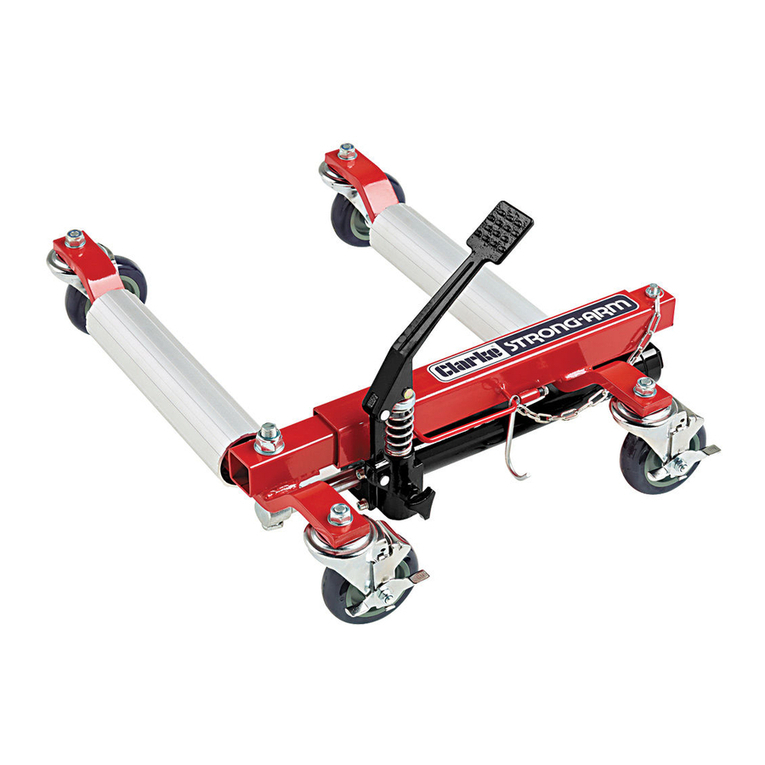
Clarke
Clarke STRONG-ARM VPJ300 Operating & maintenance instructions
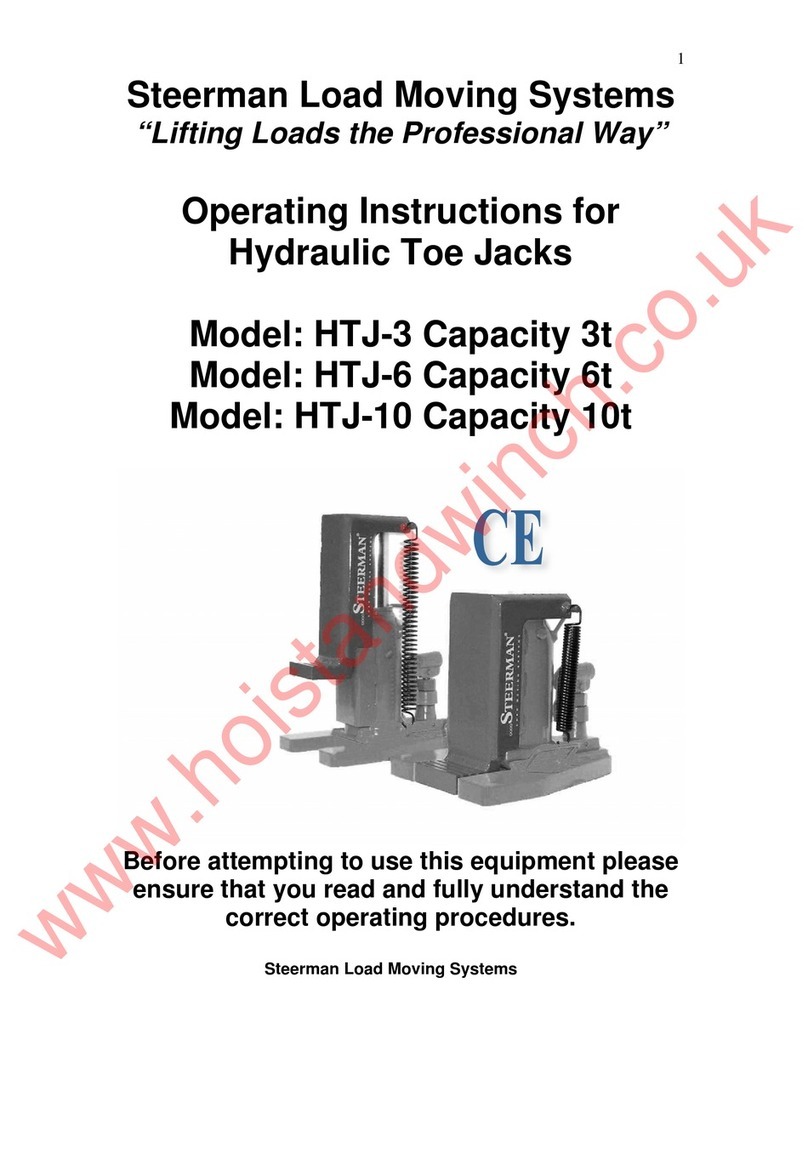
Steerman Load Moving Systems
Steerman Load Moving Systems HTJ-3 operating instructions
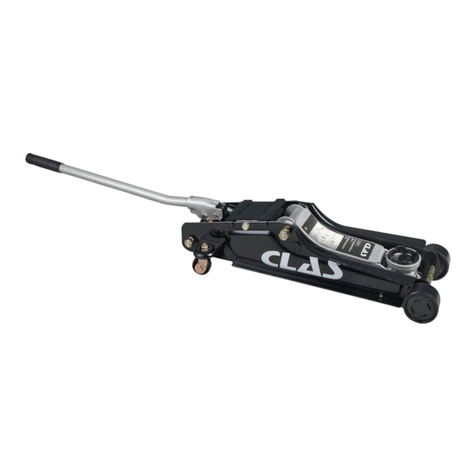
CLAS
CLAS OH 5304 manual
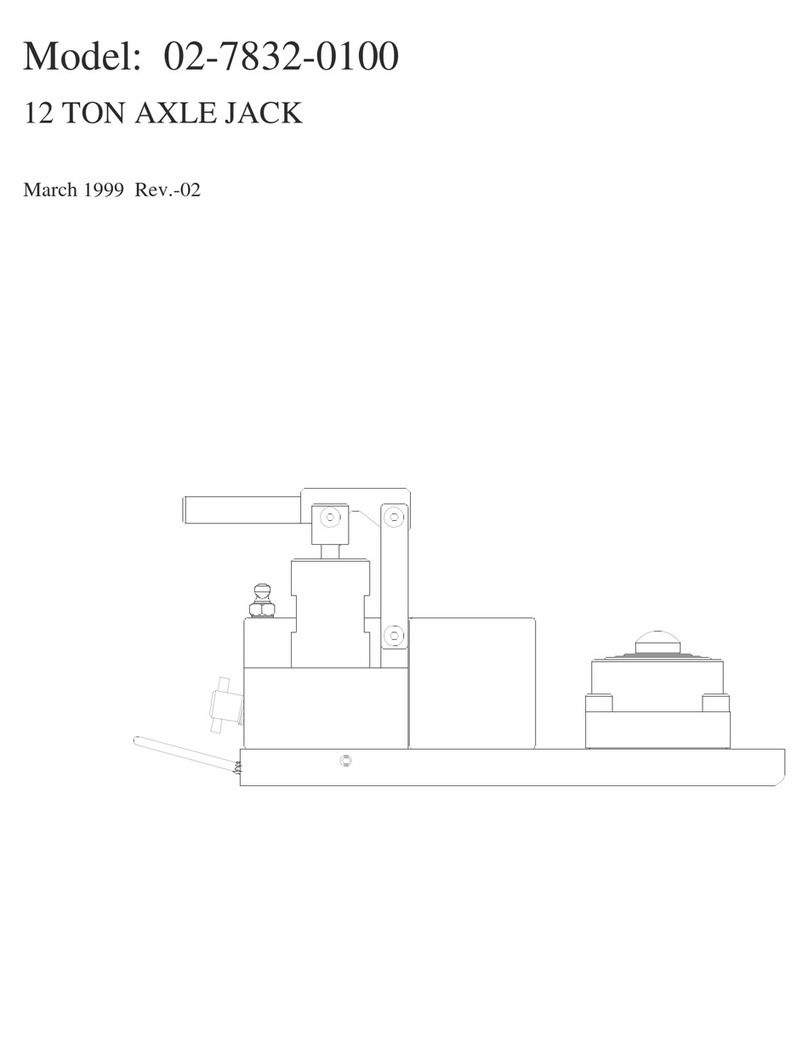
Tronair
Tronair 02-7832-0100 manual

Chicago Pneumatic
Chicago Pneumatic CP81020 Operator's manual

BlackJack
BlackJack T830018ZH owner's manual
